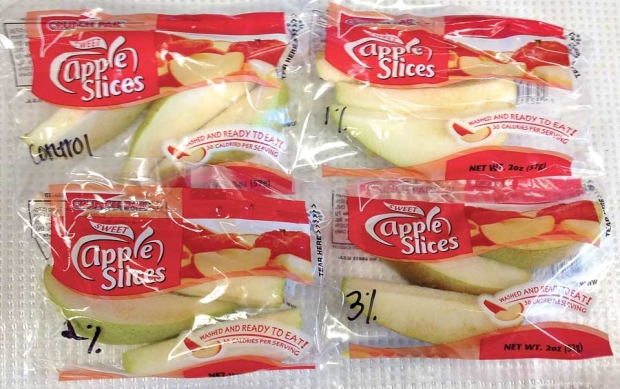
1-MCP-treated d’Anjou pears sliced and treated with the a proprietary ripening compound at 1%, 2% and 3% concentration by Crunch Pak. Note the browning of the slices at 3% concentration, indicating that the 1-MCP treated sliced fruit can be ripened by the ripening compound. As Crunch Pak does not yet produce sliced pears commercially, apple bags were used for the experiments.(Courtesy Washington State University)
Sliced apples account for ten percent of the U.S. apple market. A Washington State University scientist believes sliced pears could give the pear industry a similar boost if technical challenges can be resolved.
If the pear market could be expanded by 10 percent, by delivering high-quality sliced pears, that would translate to a $40 million positive impact on the pear industry, says Dr. Amit Dhingra, WSU geneticist. Importantly, it would increase the demand for small fruit, in the less-preferred 120 to 135 size range.
Challenges to supplying fresh sliced pears include difficulties of transporting a soft, ripened product; lack of consistency in ripening; and a short shelf life, which increases the risk for retailers or foodservice distributors who handle the product.
If unripe pears are used, the slices remain hard and dry and are unlikely to result in repeat purchases, Dhingra said.
However, Crunch Pak, a major supplier of fresh-sliced apples based in Cashmere, Washington, reports that juicy pears that have reached eating quality are not amenable to slicing, either, so pears need to be sliced while firm and ripened afterwards to develop good flavor and texture.
1-MCP (1-methylcyclopropene), which blocks ethylene perception in the fruit and prevents ripening, has been used on whole pears to maintain firmness and reduce scuffing and browning, but some treated fruit never softens and ripens.
“The 1-MCP treated pear looks pristine,” Dhingra said. “It’s in suspended animation. It’s never going to ripen, but it looks good.”
So, Dhingra and colleagues at WSU began doing research several years ago to find ways to reverse the effect of 1-MCP so that treated pears would eventually ripen. They identified nine ripening compounds, one of which is being patented by the university.
“While we were testing whole fruit, we decided to test also some sliced pears,” Dhingra explained.
They found that the ripening compound was effective on both sliced and whole fruit that had been treated with 1-MCP.
Proof of concept
That led to the idea of working with Crunch Pak to develop a sliced pear product. Last year, Dhingra obtained funding from the Fresh Pear Committee for proof-of-concept research.
Crunch Pak sliced the pears for the experiments and WSU did the scientific analysis. The ripening compound is water soluble and can be applied at the same time as the non-browning treatment that Crunch Pak applies after fruit are sliced.
In tests, 1-MCP-treated Bartlett pears were sliced at 17 pounds pressure, treated with the ripening compound, packaged in a four-ounce bag, and stored at 42.6°F for 21 days.
Dhingra said the fruit developed good flavor, juiciness, and aroma, and outlasted the two weeks of shelf life required by retailers and food-service operators. Sliced fruit treated only with 1-MCP, and not the ripening compound, remained firm and crunchy with little to no flavor throughout the 21-day period.
“The concept of the sliced pear has to be a little different from a whole pear, which is supposed to be juicy and melting, because that kind of product is impossible to deliver in the bag,” Dhingra said. “We have to think of a sliced pear as a product that retains its integrity. It’s not soft, but it gives you the flavor, aroma, and juiciness. That’s what we’ve been able to accomplish with 1-MCP and the ripening compound.”
Crunch Pak provided some of the sliced pear samples to Walmart and believes there is good potential demand for the product.
Another experiment that Dhingra conducted in collaboration with WSU food scientist Dr. Carolyn Ross, showed that the ripening compound can also be used to enhance the quality of pears not treated with 1-MCP.
In the experiment, untreated d’Anjou pears were sliced at a pressure of 15 pounds and treated with the ripening compound.
Consumers were asked to evaluate the slices during the Washington State Horticultural Association’s annual conference last December.
Although the quality of the pears was variable before slicing, the ripening treatment enhanced the overall acceptance, flavor, and texture of the slices.
More trials
Encouraged by their results so far, WSU and Crunch Pak will do further trials in the coming season with almost $70,000 in funding from the Fresh Pear Committee.
One of the goals: find out how much of the ripening compound to apply, based on the initial firmness and physiology of the pear.
At high doses, the slices ripen rapidly and the edges of the slices turn slightly brown.
WSU will purchase two pieces of equipment to measure ethylene and carbon dioxide levels, one of which is a hand-held device that can monitor ripening fruit in the bag without needing to break the bag open, so the same slices can be monitored over time.
Ross will conduct more tastings to assess consumer acceptance, and WSU agricultural economist Dr. Karina Gallardo will do studies to find out what consumers would be willing to pay for sliced pears and to estimate the potential increase in per-capita pear consumption.
Dhingra expects the product will appeal to young people who value convenience but might not find it feasible to eat whole fruit on the go. “I think we have an opportunity now with a sliced product in pears to increase consumption.” •






[…] Read the full article by Geraldine Warner here […]